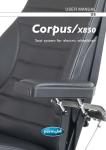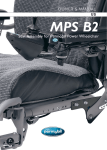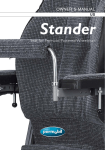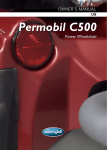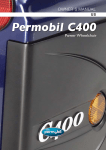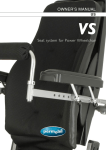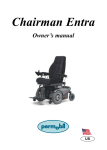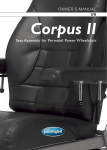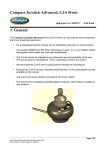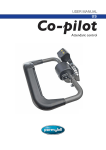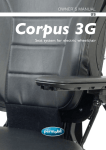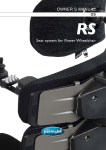Download Head Array Control System
Transcript
OWNER´S MANUAL US Head Array Control System Control device for powered wheelchair How to contact Permobil Permobil Inc. USA 300 Duke Drive Lebanon, TN 37090 USA Phone: 800-736-0925 Fax: 800-231-3256 Email: [email protected] Head Office of the Permobil group Permobil AB Box 120 861 23 Timrå Sweden Tel: +46 60 59 59 00 Fax: +46 60 57 52 50 E-mail:[email protected] Head Array Control System Owner’s Manual Head Array Control device for electric wheelchair Produced and published by Permobil AB, Sweden Edition 1, 2012-06 Article no.: 205267-US-0 Head Array Control System Owner’s Manual Table of contents Table of contents How to contact Permobil ................................................................................ 3 Important information about this Owner’s Manual ......................................... 6 Support, scrapping and spare parts .............................................................. 7 Warranty ......................................................................................................... 8 Safety rules .................................................................................................. 10 General ................................................................................................................................. 10 Specifications . ...................................................................................................................... 10 Warning labels ...................................................................................................................... 11 Safety rules ........................................................................................................................... 12 Design & function ......................................................................................... 14 General ................................................................................................................................. 14 Individual settings ................................................................................................................. 14 The Occipital pad . ................................................................................................................ 15 Additional arms ..................................................................................................................... 15 Swing-Away Lateral Arms . ................................................................................................... 16 Head Array Removal ............................................................................................................ 17 Operation ...................................................................................................... 19 General ................................................................................................................................. 19 Head Array basics ................................................................................................................ 20 Engage switch ...................................................................................................................... 21 Using your Head Array System ............................................................................................ 22 Maintenance ................................................................................................. 28 Cleaning . .............................................................................................................................. 28 Technical specifications ............................................................................... 29 5 Important information about the user manual Head Array Control System Owner’s Manual Important information about this Owner’s Manual We congratulate you on your choice of a product from Permobil. Our goal is for you to continue to feel satisfied with your choice of both vendor and product. Before you begin using this product, it is important that you read and understand the content of these operating instructions and in particular the Safety Instructions. These operating instructions are primarily intended to acquaint you with the functions and characteristics of the Head Array Control System and how you can use it in the best manner possible. They also contain important safety and maintenance information, as well as describing possible problems that can arise during use. Always keep these operating instructions handy in connection with your wheelchair, since the need for important information can arise concerning its use, safety and maintenance. It is also possible to obtain information concerning our products from our home page on the Internet. You can find us at www.permobil.com. All information, pictures, illustrations and specifications are based upon the product information that was available at the time that these operating instructions were printed. Pictures and illustrations that are found in these operating instructions are representative examples and are not intended to be exact depictions of the various parts of the Head Array. We reserve the right to make changes to the product without prior notice. Ordering of documentation If you are in need of another copy of the Owner’s Manual, it can be ordered from Permobil, ask for item No. 205267-US-0. 6 Head Array Control System Owner’s Manual Support, scrapping and spare parts Support, scrapping and spare parts TECHNICAL SUPPORT In the event of technical problems, you should contact your dealer or Permobil Inc USA at 1-800-736-0925. Always state the device and chassis serial number when contacting Permobil to ensure that the correct information is provided. SPARE PARTS & ACCESSORIES Spare parts and accessories must be ordered through your dealer. SCRAPPING THE HEAD ARRAY Contact Permobil Inc. for information about scrapping agreements in force. 7 Warranty Head Array Control System Owner’s Manual Warranty WARRANTY Permobil Inc. warrants the Total Control Head Array System to be free from defects in material and workmanship for a period of one year under proper use, care and service. All warranties will cover parts only and do not extend beyond the initial purchaser from an authorized Permobil Dealer. Commencement of Warranty Period Each warranty shall begin on the date the product is first delivered to the customer, or forty (40) days from the date the product is shipped to the Dealer by Permobil, whichever comes first. Repair or Replacement For warranty service, customers should contact the Dealer from whom the product was purchased. In the event of a defect in material or workmanship, the Dealer must obtain a return authorization (RA) number from Permobil and the product must be shipped to a service center designated by Permobil. Permobil will repair or, at Permobil’s option, replace any product covered by the warranty. This warranty does not include any labor or shipping charges incurred in replacement for installation or repair and any such product. Disclaimer and Limitations of Remedies The express warranties set forth in this agreement are in lieu of all other warranties of merchantability or fitness of purpose. In no event shall Permobil be liable for any direct, indirect, incidental or consequential damages resulting from any defect in this product. Warranty of parts subject to “normal wear and tear” (e.g. pads, upholstery) are not covered in this warranty except as it applies to defects in material or construction. After the initial one-year period, or if the product is sold or ownership is otherwise transferred, replacement parts are subject to a 90 day warranty period and only in the event that the part is replaced according to requirements set forth in this agreement (see “Voiding of Warranties”) 8 Head Array Control System Owner’s Manual Warranty WARRANTY Amendments No person is authorized to alter, extend or waive the warranties of Permobil. An original document, countersigned by the party or parties concerned must be received by Permobil Inc. before any such amendment will be in effect. This warranty shall be extended as necessary to comply with state laws and requirements. Voiding of Warranties The foregoing warranties are contingent upon the proper use, maintenance and care of the product. The warranty will be void if the product has been used improperly or if it has been repaired or any part replaced by persons other than Permobil or an authorized Dealer. The addition of equipment or features that are not manufactured or recommended by Permobil could affect the intended function of the Permobil product. The use or installation of non-Permobil issued equipment may invalidate the warranty. 9 Safety rules Head Array Control System Owner’s Manual Safety rules General The Permobil Total Control Head Array system is intended to be fitted to Permobil power wheelchairs equipped with Pilot+ or R-net electronics. Incorrect use may lead to risk of injury to the user and damage to the wheelchair or other property. In order to reduce these risks, you should read through this instruction manual carefully, paying particular attention to the safety instructions and the warning texts. Any unauthorized use of Permobil Total Control Head Array System may lead to increased risk of accident. Follow the recommendations in the Operation section carefully in order to prevent the risk of accidents from use. All alterations to and interventions in the head array’s vital systems must be performed by a qualified service engineer. In case of doubt, always contact a qualified service engineer. Specifications All information and specifications contained in this instruction manual applied at the time of delivery of this product. As Permobil undertakes continuous development and improvement, we reserve the right to make changes without prior notification. 10 Head Array Control System Owner’s Manual Safety rules Warning labels The user manual contains the following Warning Labels, which are intended to draw attention to situations that could lead to unwanted problems, personal injury or damage to the wheelchair, etc. m CAUTION! Please use caution where this symbol appears. m WARNING! Please use extreme caution where this warning symbol appears. Failure to observe warnings can lead to personal injury and property damage, including damage to the wheelchair. 11 Safety rules Head Array Control System Owner’s Manual Safety rules m CAUTION! Permobil accepts no liability for personal injury or damage to property that may arise from the failure of the user or other persons to follow the recommendations, warnings and instructions given in this owner´s manual. Recycling of electronic parts Obsolete electronics should be disposed of responsibly in accordance with local recycling regulations. EMC requirements The electronics in the head array may be affected by external electromagnetic fields (e.g. from mobile phones). Likewise the electronics in the head array may themselves emit electromagnetic fields which could affect the surrounding area. The threshold values for Electromagnetic Compatibility (EMC) relating to electric wheelchairs and their accessories are laid down in harmonized standards under EC Directive 93/42/EEC Medical Devices. Additionally, the US FDA has set forth guidelines for Power Wheelchairs and their accessories to have a minimum Electromagnetic Immunity (EMI) level of 20 V/m. The Permobil Total Head Array Control System meets or exceeds both of these minimum threshold values. 12 Head Array Control System Owner’s Manual Safety rules m WARNING! Assembly The Permobil Head Array should only be fitted by a qualified service engineer or someone with adequate knowledge to perform the adjustment in an expert manner. Maintenance and service Carry out only the service and maintenance activities specified in this user manual. All other service, alterations to and interventions in the Permobil Total Control Head Array System and its vital systems must be carried out by a qualified service engineer or someone with adequate knowledge to perform the adjustment in an expert manner. In case of doubt, always contact a qualified service engineer or Permobil. Use only spare parts or accessories approved or recommended by Permobil. All other use could lead to changes which might impair the function and safety of the product. It could also lead to the warranty becoming invalid. Proximity Sensors and Moisture Proximity Sensors can be activated by moisture and/or dampness within 3/4” (20 mm) of the front of the sensing area. This can be the result of rain, wet hair, perspiration, hair products, liquid spills, etc. Proximity Sensors in the Head Array sense the approach of a body part and effect a drive signal in the wheelchair drive electronics. The power wheelchair may move unexpectedly if moisture is affecting the operation of a Proximity Sensor. Unexpected and unintentional operation of a power wheelchair can result in property damage, personal injury and even death. At the first sign of unintentional operation switch the wheelchair off at the On/Off Switch or activate the Head Array’s Disengage Switch to stop the wheelchair’s movement. Thoroughly dry the pad area around the sensors and particularly the area directly in front of each sensor. Switch the wheelchair back on/re-engage the Head Array and confirm that the unintentional operation has stopped before resuming use of the power wheelchair. 13 Design and function Head Array Control System Owner’s Manual Design & function General The Permobil Head Array System is attached to the rear of the wheelchair’s backrest. The position of the Head Array System, as well as its individual sensors/ switches, can be adjusted to optimize user performance for drive and control activities. The Total Head Array Control System works together with a Pilot+ or R-net OMNI control interface to provide control of the power wheelchair instead of an ordinary control device. The operation of the wheelchair and its functions are controlled by moving the head, or other body part, within activation range of the proximity sensors or by physically activating the mechanical switches (if used). Individual settings Fig. 01. Depicts a ‘basic’ configuration with a left and right sensor arm equipped with sensors and the Occipital equipped with a small pad. Many variations are possible. In addition to positioning and locating the sensors/switches specific to the user’s needs, the Head Array System’s performance is customizable through programming of the power wheelchair’s drive electronics. Discuss this with your clinician, supplier or Permobil representative. 14 Fig. 01. A basic Head Array setup. Head Array Control System Owner’s Manual Design and function The Occipital pad The occipital pad has two sensors that help to make driving easier by providing a larger target. The occipital pad can be equipped with either a small or a large pad. The occipital pad is also the interconnection unit for the Head Array System Fig. 02. The functionality of the sensors/ switches is determined by which input port is connected i.e. Forward, Reverse, Left, Right, Mode or On/Off. Fig. 02. The connection panel located on the Occipital Pad. Showing input ports for 3.5 mm jack connectors. m CAUTION! Do not tamper with or change the way the connectors are plugged in, as it may cause a dangerous circumstance. Seek help from an individual qualified to work on Permobil products if connection changes are required. Additional arms Permobil’s Head Array System can be equipped with additional arms and arm extensions. Any of the appropriate sensors or switches in the Permobil Head Array System product range can be utilized on the arms. Fig. 03. Shows a configuration with one additional arm equipped with an Egg Switch (typically used for the Mode function). Fig. 03. Head Array with an additional arm mounted. 15 Design and function Head Array Control System Owner’s Manual Swing-Away Lateral Arms The Total Control Head Array System has two release buttons at the back that can be used to swing-away the left and right side lateral arm assemblies for easier transfers or care activities. Each release button is a combined push button and locking knob. The locking knob eliminates side-to-side “play” of the lateral arms. Quick release The quick release buttons marked with a green dot, release the arms to swing out of the way laterally. 1 Loosen the quick release button screw by turning it counter-clockwise until it just protrudes from the back surface of the head array. Fig. 04 B. 2 Push the quick release button and swing the arm gently back. If the arm doesn’t swing freely or will not release, loosen the screw further until the button can be depressed fully, then swing away the arm. 3 To return the arm to its operating position, swing the arm back toward the front of the head array. The push button will lock the arm to its preset index. 4 The locking knob prevents “play” in the lateral arm. The locking knobs do not need to be tightened; however if left loose, this will allow slight side-to-side “play” to be present in the lateral arm(s). A B Fig. 04. Swing away buttons. ‘A’ in locked position, ‘B’ unlocked and may be pushed to release the arm. m CAUTION! Forcing the arm to swing away other than as described above will damage the locking mechanism. 16 Head Array Control System Owner’s Manual Design and function Head Array Removal The entire Head Array assembly can be removed from the wheelchair, to increase access to the user’s head for transfers or care activities. Dismount 1 Make sure the wheelchair has been switched off. A 2 Release any cable straps down to the inline connectors located at the top of the backrest. 3 Unlock the 9-pin connector by fully loosening the two screws, gently pull the connector apart. Fig. 05 A. 4 Disconnect the 3.5mm connectors by grasping each body and pulling apart (do NOT grasp the wires). B Fig. 05. The Permobil Head Array and OMNI are interconnected with a 9-pin connector ‘A’ and a 3.5mm stereo connector ‘B’. 5 Move the release handle on the rear of the backrest to the unlocked position. Fig. 06. 6 Remove the head array by lifting straight up, being sure that no cables are snagged in the process. Fig. 06. Open the handle to remove or fit the Head Array. 17 Design and function Head Array Control System Owner’s Manual Mounting Fit in the reverse order. 1 Be sure the release handle is moved to the locked position. 2 Confirm that the locking screws on the 9-pin connector are securely fastened. 3 Be sure the 3.5 mm connectors are firmly mated. 4 Re-secure the cables using the velcro cable straps that were opened during the removal steps. m CAUTION! Removal of the head array should not be attempted except by individuals familiar with the process as there may be multiple attaching devices used to safely and properly secure the head array and protect the cables. 18 Head Array Control System Owner’s Manual Operation Operation General The Permobil Head Array is designed for use both indoors and outdoors. For use indoors, normal care should be observed. Outdoors you must remember to move very slowly on steep inclines and be extremely careful when moving over uneven surfaces, on ascents and sideways slopes. See the wheelchair’s instruction manual for more information on the chair’s driving rules. The Head Array’s electronics ”interpret” the movements of the head and other body parts to move the wheelchair as intended. Configurations The Head Array can be configured in several different ways. Up to four lateral arms, long or short, can be in use. A number of pads can be in use. • Pads with proximity sensors sends an impulse as soon as you get close to them. • Pads with mechanical switches have to be pressed to send a signal. • Passive support pads are used as support to improve positioning and stability. The jack a sensor/switch is plugged in to on the connection panel located behind the occipital pad determines the function for that specific sensor/switch. Auto safety check The Total Control Head Array System continuously checks its internal state and the state of the sensors. Audio Feedback Confirmation The Head Array System has an audio confirmation function. This function provides clicks & beeps (dots and dashes) to indicate activation of the various sensors/switches. This feature is turned OFF by default. If you feel you would benefit from this feature, discuss it with your supplier so they can enable it for you. 19 Head Array Control System Owner’s Manual Operation Head Array basics The basic configuration and setup consists of an occipital pad, two lateral arms, each bearing a pad with proximity sensors. Fig. 07. The wheelchair is operated by the sensors in the pads, the sensors can be used to: • drive the wheelchair. • control the seat functions. • navigate the menus. t/ lef te n r a Tu vig h Na roug s th enu m Drive Forward/ Reverse Navigate through Menus Tu r Na n r i th vig ght ro at / m ug e en h us Fig. 07. The basic Head Array configuration. m WARNING! The proximity sensors may inadvertently activate when exposed to rain, excessive moisture or wet hair. This may cause the wheelchair to drive in an unintended manner, creating a dangerous situation. 20 Head Array Control System Owner’s Manual Operation Engage switch The engage switch allows you to switch between active and stand-by mode. In stand-by mode the Head Array’s sensors are inactive and not powered. Fig. 08. The LED indicators, located on the left and right of the engage switch, display the current mode: • • • • Solid Green: Active mode, all direction signals neutral Solid Amber: Active mode, one or more direction signals active Flashing Amber: Stand-by mode (sensors inactive) Fig. 08. Engage switch. LED-indicators to the left and right. Flashing Red: Error – Report number of flashes to your provider for assistance Reconfigure Reconfigure refers to the ability of the Head Array System to adjust itself to various Sensor and Switch combinations. Your healthcare professional will complete this process during the initial setup and configuration of the head array. m WARNING! Do not activate this process as it may disrupt the normal function of your system and create a potentially dangerous operating condition. 21 Operation Head Array Control System Owner’s Manual Using your Head Array System Your Total Control Head Array System is capable of operating all of the modes and functions of your wheelchair. Your healthcare provider will tailor the operation of your Head Array System to meet your individual needs. This may include changing the functionality and/or position of some of the head array’s sensors/switches. The method that you use to control your wheelchair using your head array system will vary depending on how your provider has programmed the system and configured the sensors/switches. Once the system is setup to meet your needs, your provider will train you on the operation of your Head Array System. If you are unsure how to use your head array to control your wheelchair, consult with your healthcare and/or equipment provider. Before you start using the Head Array System in public places, we recommend that you try it out several times in an area with familiar surroundings, so that you become comfortable with how the head array operates. The information below describes the basic operation of a Head Array System. Straight Forward movement While in drive mode, activating the head array’s Forward Direction sensor will make the wheelchair move in a straight forward direction. Typically, the sensors built into the occipital pad provide a Forward Direction signal to the wheelchair drive electronics. • Forward Direction signal from Occipital Sensors: To drive straight forward, move your head slowly toward the occipital pad until you are within range of the sensors. Resting your head against the occipital pad will give you support while the wheelchair is in motion, as well as, giving a continuous forward drive movement. • Forward Direction signal from other sensor/switch: To drive straight forward, activate the sensor/switch which provides a forward drive command to the wheelchair electronics. Continuous activation of this sensor/switch will provide a continuous forward drive movement. 22 Head Array Control System Owner’s Manual Operation Stopping Moving outside of the activation range of ALL sensors/switches that provide drive signals to the wheelchair drive electronics will stop the wheelchair’s movement. An exception is when the wheelchair electronics have been programmed for latched driving. In cases where latched driving is active, it may be necessary to activate a reset switch to stop the wheelchair’s movement. Your provider will give you more details if your wheelchair is setup for latched driving. Turning on the spot Activating the Right-direction or Left-direction sensor/switch without activating the Forward-direction or Reverse-direction sensor/switch, will turn the wheelchair around in the smallest possible space. Veer commands During straight forward driving, it is possible to make a course-correction movement (veer) by activating the left or right sensor/switch at the same time as the forward sensor/switch. Veer movements are useful when navigating a path that contains gentle curves. How sharp your wheelchair turns during a veer is controlled by the profile and speed chosen. Your provider can also adjust the sharpness of the veer through programming. m CAUTION! If you are turning to the left or right and at the same time activate the sensor/switch for the opposite direction for more than 60 seconds, the head array will stop sending directional commands to the wheelchair drive electronics. To continue driving, leave the activation range of all sensors (move to neutral) then you can commence driving again. 23 Operation Head Array Control System Owner’s Manual Reverse direction command The way your head array is configured, combined with the way that the wheelchair drive electronics are programmed, will determine how you access a reverse direction command. Here are the three most common methods: • Mode Switch (user switch): An arrow on the Omni display will indicate which direction the wheelchair will travel when the “forward” direction sensor/switch is activated. While in driving mode, give a brief activation of the ‘Mode’ switch, and release. The direction arrow will change. Now, a “forward” switch activation will result in the wheelchair traveling in the reverse direction. A brief activation of the mode switch will toggle the direction arrow back to the other direction. • Forward/Reverse Auto-Toggle: An arrow on the Omni display will indicate which direction the wheelchair will travel when the “forward” direction sensor/switch is activated. The Omni interface can be programmed to automatically toggle the direction of this arrow when a brief “forward” switch activation is given. To change the indicated direction, briefly activate the “forward” sensor/switch and release. The arrow’s direction will change. To move the wheelchair in this direction, activate the “forward” sensor/ switch again and the wheelchair will move in the direction indicated. 24 Head Array Control System Owner’s Manual • Operation Dedicated Reverse Switch: The Total Head Array Control System includes a reverse jack that enables a dedicated reverse sensor/switch to be connected to the head array. When this jack is used, and the wheelchair electronics are programmed accordingly, there will be a separate sensor/switch that provides reverse direction commands to the wheelchair drive electronics. To move the wheelchair in the reverse direction, activate the “reverse” sensor/switch. To stop moving in the reverse direction, release the sensor/switch. m CAUTION! If you are driving forward and at the same time activate the sensor/switch for the reverse direction for more than 60 seconds, the head array will stop sending directional commands to the wheelchair drive electronics. To continue driving, leave the activation range of all sensors (move to neutral) then you can commence driving again. 25 Operation Head Array Control System Owner’s Manual Changing Operating Mode The operating mode of the wheelchair electronics determines which wheelchair function the head array is controlling. Examples of operating modes are: Driving, Seat Functions, Mouse Control, and Infrared Control. The different modes your wheelchair is able to access is determined by the devices connected to your wheelchair and how your wheelchair electronics are programmed. The head array can be used to switch between the wheelchair’s operating modes in one of three ways. The method that you use is determined by the configuration of your head array and the programming of your wheelchair electronics. • Mode Switch to Menu: While no other direction commands are being given, activate the mode sensor/switch briefly. The Omni interface will enter the “User Menu” screen. Once in the User Menu, the head array’s directional sensors/switches are used to navigate through the menu. The way the head array navigates the menu is adjustable via programming. Typically, a forward command will move the highlight to the next choice and left/right commands will adjust or select the highlighted menu option. 26 Head Array Control System Owner’s Manual • • Operation Time Out to Menu: After a period of inactivity (adjustable through programming) the Omni interface enters the “User Menu” screen. Once in the User Menu, the head array’s directional sensors/switches are used to navigate through the menu. The way the head array navigates the menu is adjustable via programming. Typically, a forward command will move the highlight to the next choice and left/right commands will adjust or select the highlighted menu option. Sequence using Mode Switch: Use the mode sensor/switch to navigate through each operating mode directly. Each activation of the mode sensor/switch will select a new operating mode. m WARNING! Do not attempt to operate a power chair with a Head Array without the assistance and training from a healthcare professional qualified for these activities. Do not attempt to independently operate a power chair with a Head Array until a qualified healthcare professional gives you the go ahead. 27 Maintenance & Technical specifications Head Array Control System Owner’s Manual Maintenance Cleaning The metal parts on the head control can be cleaned using a damp cloth. If they are very dirty, use soapy water on the surface. Wipe all parts properly after cleaning. The pads must be cleaned with a cloth moistened with soap water once a week. During hot weather conditions with the risk of sweating the pads must be cleaned every day. Wipe all parts properly after cleaning. As moisture affects the operation of Proximity Sensors, make sure that all surfaces of the Head Array are completely dry before it is used to operate the wheelchair again. m WARNING! Never wash using a water hose as the electronics may be damaged. 28 Head Array Control System Owner’s Manual Maintenance & Technical specifications Technical specifications DATA Name .......................................................... Permobil Head Array Control System Interface Connector ..................... Female 9-pin D-sub,3.5mm mono plug (On/Off) Operating Voltage ....................................................................................... 12v DC Maximum Current Usage ............................................................................... 75mA Omni SID Control Type ................. 3-axis Switched Input or 4-axis Switched Input Input Jack Type ................................................................... 3.5mm Stereo Socket Input Compatibility ..................... 1/8” Mono Ability Switch, 3-pin Proximity Sensor Proximity Sensor Connector Pin-Out (3.5mm Stereo Plug) Tip ............................................................... Switch Closure (open collector) Ring ........................................................................ 12v Supply (15mA max) Sleeve ............................................................................................... Ground 29 US Order. No: 205267-US-0
































